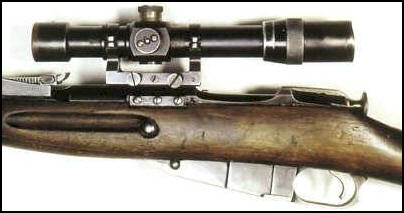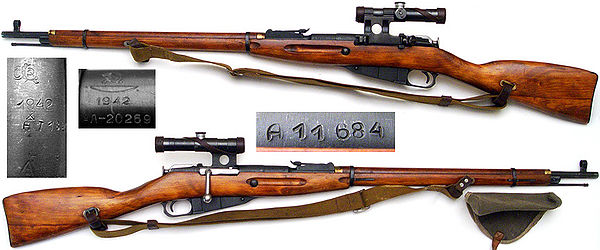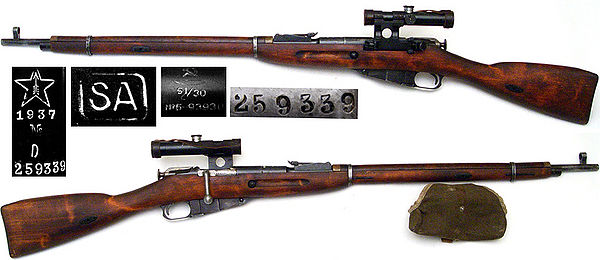Sniper
Rifles
Russia/USSR
Mosin Nagant
| General Specifications |
Sniper Rifle General Description: |
|
Weight
-- 8 3/4 lbs.(4.0 kg)
Length (over all) -- 48 1/2" (123.2 cm)
Barrel Length -- 28 3/4" (73.0 cm)
Stock length -- 45" (114.3 cm)
Magazine -- 5 Rounds Integral box
Muzzle Velocity: -- 2850 fps
Effective Range: --1000 meters
|
- Still
commonly found on modern battlefields around the world
- 3.5-power
PU fixed focus scopes
- Production
of the Mosin Nagant sniper rifles began in 1937 and ended in 1963
- Featured
a turned down bolt to clear the optics
|
The Mosin–Nagant Model 91/30 was adopted and modified to be a sniper
rifle in 1932. It was adapted for sniper use by adding a telescope. The
telescopes were somewhat similar to those used on US hunting rifles at
that time. The Model 1891/30 PU was issued with 3.5-power fixed focus
scope to what the Soviets then called sharp shooters. It served quite
prominently in the brutal urban battles on the Eastern Front, such as
the Battle of Stalingrad, which made heroes of the Soviet snipers many
of which were women.
The 91/30 PU sniper rifle is an upgrade of the standard Model 91/30
rifle. The functional and robust bolt and magazine remained essentially
unchanged except for the bent bolt which allowed it to clear the scope
so a round could be easily chambered. The sniper rifles were highly
respected for being very rugged, reliable, accurate, and easy to
maintain.
The 91/30
PU's were generally built to more exacting standards than their
standard issue counterparts. The standard M91/30's were thought to have
been fired and the best of the lot were selected to become sniper
rifles. Once selected the triggers were reworked and the finish on the
later PU snipers were better than the standard infantry rifles.
Unlike the other combatants, Soviet Russia had a well established
sniper rifle manufacturing and training program in place when Germany
forced its entry into World War II with the launch of Operation
Barbarossa invasion in 1941.Based on the low wall 91/30 rifle with a
hexagonal and round receivers, there were at least three sniper rifles
using different chamber and bolt body scope mounts. Ironically, the
Soviets received the bulk of their sniping expertise from military
exchanges with the fledgling Nazi regime in the 1930s. Thus in 1942
work began on a sniper rifle that could be mass produced.
A few rifles were used with 26mm (1.02in) diameter rubber baffle
silencers weighing about 480gm (1lb 1oz). Silenced weapons could only
fire subsonic "partisan" ammunition with green marks on the bullet,
case or primer otherwise the baffles were destroyed after a few rounds.
The first
examples of the 91/30 PU came from the production lines in Tula and
Iszevsk late in 1942, and the weapons remained the front line sniper
rifles for the now-defunct Eastern Communist Bloc. Both the rifle and
the sniper rifle were standard issue in some Soviet satellite armies
into the 1970s until they were superseded by the infamous self-loading
SVD Dragunov which is chambered for the same caliber round and remains
in service today.
It has been believed that that 185,000 sniper rifles were produced
during the war but because of the secretive nature of the Soviets
during the Cold War era, the subsequent manufacture, and re-manufacture
of the weapons by numerous satellite states, and the chaotic state of
the former USSR since the Iron Curtain finally came down, definitive
manufacturing figures for 91/30 PU sniper rifles are hard to come by.
The Mosin Nagant Sniper rifle has been used by third world countries
after the conclusion of World War II seeing service in the Korean
Conflict by the North Koreans from the beginning, and Chinese
Communists about a year later, during the Korean War. They were also by
the North Vietnamese in the Viet Nam War. American soldiers brought
back several Mosin Nagant Sniper Rifles after they were used against
American and South Vietnamese forces.
The 7.62 round is still being used as efficient sniper ammunition. In
2007 an American Sniper in Iraq using the standard issue M24 Sniper
Rifle firing 7.62x51 NATO rounds which have a muzzle velocity of 2800
fps. The rifle and round were rated as having a maximum distance of
875yds (800m). The Sniper was tasked with removing an enemy sniper who
thought he was out of range of the US Sniper as he was 7/10 of a mile
away, 1230yds (1130m). Once the US Sniper made his calculations he sent
the round and it became the longest Sniper Kill ever with a 7.62 round.
This puts into perspective what the Soviet Snipers were able to do with
the Mosin Nagant Sniper Rifle over 50 years ago.
Sniper
Variants
PE
Snipers :
The first
series of Soviet sniper rifles used the Model PE scope (VP in the
Soviet designation) which was produced by the company Emil Busch AG and
was basically a copy of the Zeiss optics used on the first prototypes.
Russian sights were made in a factory equipped by Carl Zeiss of Jena.
The 4 x4 PE type had a 30mm objective lens, a field of view that is 8°
30' azimuth and elevation adjustments were internal. It gave good
optical performance for its day but it was comparatively heavy. The
earliest sights were mounted in a single piece, twin split ring mount
held on the receiver ring above the chamber but this was replaced by a
twin split ring mount fitted to a dove tailed base plate on the left
side of the receiver.
This series of rifles ran from 1931 to 1939 with some evidence
indicating that the production run went into the early 40's to use up
surplus parts from the official production run. The PE scope is
identified by its length which extends from just even with the iron
sight base back to just beyond the cocking piece on the bolt and the
use of an adjustable objective or eyepiece. The PE was a 4 power scope
that featured adjustments for elevation and windage as well as the
focus ring. The first mounting system was a hex shaped affair that
mated with the hex receiver and mounted the scope on the center line of
the bore. This center line mount was later adapted to the round
receivers. Later mounting systems for the PE and PE/PEM series were
side mounts that attached to a base affixed to the left side of the
receiver.
- Mosin
Nagant PE Sniper Rifle

PEM Snipers :
The Soviets received the bulk of their
sniping expertise from military exchanges with the fledgling Nazi
regime in the 1930s, and the PE and PEM 4-power scopes mounted on the
first 91/30 sniper rifles was a direct copy of a design by the famed
German optical manufacturer Zeiss. However, as fine as these earlier
Soviet sniper rifles were – to the point they were prized items often
pressed into service when captured by the German invaders, who often
had to rely on civilian target and hunting rifles pressed into service
as sniping weapons – Russia could not produce them in the quantities
demanded by a massively expanded military, fighting with its backs to
the wall against a professional and determined enemy. Thus in 1942 work
began on a sniper rifle that could be mass produced.
In 1938 the PEM received the side mounting system that attached to the
left side of the receiver in a side rail. This mounting system allowed
better access to loading the weapon and gave more clearance for the use
of the iron sights on the weapon finding one of these examples today is
extremely rare.
- Mosin
Nagant PEM Sniper Rifle

The two
early models of scopes mounted on the 91/30 were referred to as PE and
PEM which stands for "unified model" and "unified model modern"
respectively. The difference between the two are significant as the
early PE allowed for focus adjustment whereas the PEM did not. The move
away from the focus ring was to simplify production and to attempt to
stem reported problems with the scopes "leaking" due to poor seals.
There is some confusion over the designation PE/PEM which according to
the source you read designates a transitional production series from
1937 through 1939 or the entire series of rifles produced after the
introduction of the PEM.
PU Snipers :
By far
the most commonly encountered 91/30 PU sniper rifles were manufactured
at Izsevsk, and they are readily recognized by the arsenal’s hammer and
sickle within a wreath on top of the chamber, and a number with at
least seven digits and Cyrillic characters stamped into the left side
of the chamber. Iszevsk manufactured components - right down to the
barrel bands and butt plate - have a triangle with a fletched arrow
inside stamped into them.
In keeping with Soviet war time austerity, the PU scope is basic, but
robust and effective. With a magnification of 3.5-power and 169mm (6.7
inches) in length and weighing 270 grams (9.5 ounces), the PU is a
simple design with a European three post reticule, and it was quicker
to manufacture. With the scope fitted, all 91/30 PU rifles were issued
with an roughly woven cloth action shroud with a leather strap which
passed through the trigger guard, which doubled as a case for the scope
when it was removed with the detachable mount. Each rifle also had a
set of leather scope caps, although examples in East German service
have been encountered with plastic caps linked with black elastic cord.
Like the rifles, there are huge variations in the optical sights, with
wartime dated markings varying from the Soviet hammer and sickle in a
pentagon, through to later examples with just a serial number, and new
and refurbished scopes with multi-coated lens elements. The windage
dial, on the left of the scope is calibrated plus and minus to 10, and
the elevation dial is marked out to a (very optimistic) 1300 meters. As
with many European scopes of the era, the cross hair does not remain
centered, but shifts with adjustment. The PU scope has been adapted for
a variety of heavy weaponry, including 14.5 anti-aircraft guns and
12.7mm machine guns, and these can generally be recognized by extra
increments on the elevation dial – 91/30 scopes stop at 13, whereas
heavy machine gun scopes often go up to 22 - although they have an
identical three post reticule.

Photo
donated by Empire Arms: www.empirearms.com
- Other
Countries Mosin Snipers :
The
Soviet Union wasn't the only country to use Mosin Nagant Sniper Rifles
during World War II. Shown below are some variants.
- Finnish Mosin Nagant M91/30 Sniper
Rifle
During World War 2, the Finnish Army captured and reissued any M/91-30
sniper rifles they encountered. Almost all of them were returned to
front line service immediately upon capture but those that were damaged
were returned to the arms depots for either repair or stripped for
parts and the optical components and mounting hardware. The number of
rifles that were captured during the Winter War because of Soviet
trained snipers was unknown, these soldiers did not tend to surrender
easily. Most Finnish captured sniper rifles came from positions quickly
overrun. Soviet snipers were trained to damage or destroy their rifles
in the event of defeat or imminent capture.

Photo
donated by Empire Arms: www.empirearms.com
- Polish Mosin Nagant M91/30 Sniper
Rifle

Photo
courtesy of Forum Member martin08
- Hungarian M/52 Sniper Rifle
Hungarian M/52 sniper rifles are among the rarest examples of the PU
family, and, since standard Hungarian 91/30 rifles are even rarer than
their scoped cousins. They are readily recognized by their higher
standard of manufacture, a deeper blue/black finish of all metal, and a
profusion of “02” (apparently the Eastern Bloc designation for
Hungarian manufactured weaponry) stamps on just about every component
of the weapon - right down to the shaft of the cleaning rod. The scope
mount components also display finer attention to detail during
manufacture and are generally unmarked, save for customary “02” stamps.
The
marking on the rifle’s chamber are utilitarian. An 02 above the year of
manufacture and then the serial number which is generally two letters
followed by four digits. There is also evidence of “blond", almost
yellow timber on unissued rifles. Like the Russian rifles, the
Hungarian stocks have a brass-reinforced “dog collar” sling mount
slots. M/52 rifles can be fitted with an all leather sling or webbing
varieties in varying colors, again the 02 marking readily denotes their
origin. Hungarian scopes are identical to the Russian PU optics except
for the markings, all markings are in white with the scope number being
a "41" that is apparently an indication of Hungarian manufactured
optics that is also seen on military binoculars above a four digit year
of manufacture, then the serial number.
There is
also another four digit number, indicating the serial of the rifle the
scope was issued with. Hungarian M/52 rifles have been encountered with
Russian manufactured scopes or mounts, but whether these came together
in the various countries the weapons were exported to as military aid
during re-build programs, or the components were fitted to rifles
without optical sights by civilian collectors can only be conjecture.

Article written by JoeR, Wiki Contributor,
russian-mosin-nagant-forum.com
|

